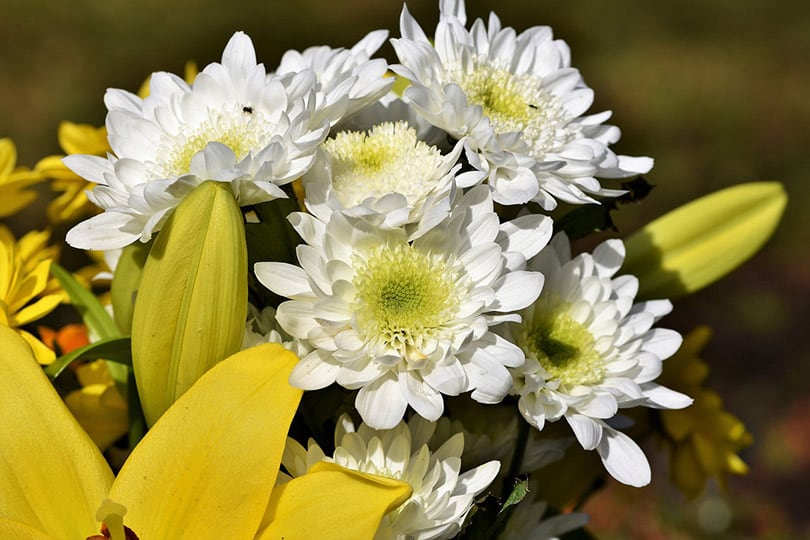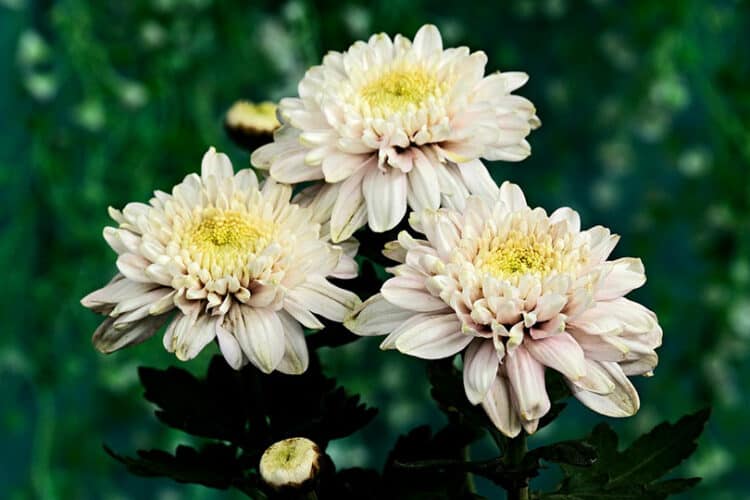Mums—also known as chrysanthemums and daisies—are flowers for all occasions. They’re simple, pretty, and come in a variety of colors, some of which even have symbolic meaning for those interested in the language of flowers. Unfortunately, the effect they can have on dogs isn’t so pretty. According to the ASPCA, mums are poisonous to dogs.
Side effects of chrysanthemum poisoning range from mild to severe, so if your dog has eaten a chrysanthemum or you suspect that they may have done—even if they’re not showing symptoms—contact your vet immediately to find out what you should do next.
Why Are Mums Toxic to Dogs?
Mums contain certain properties that are poisonous to dogs, as well as cats and horses. They are primarily sesquiterpene, lactones, and pyrethrins, but other irritants may also be present, according to the ASPCA.
For these reasons, if you’re a fan of mums, it’s important to make sure you keep them somewhere out of your dog’s reach. If you keep them in your garden, you may want to consider fencing off the area, along with other potentially toxic plants.
What Are The Symptoms of Chrysanthemum Poisoning in Dogs?
Symptoms of chrysanthemum poisoning can manifest internally or on your dog’s skin, so symptoms can vary. One potential symptom of chrysanthemum poisoning is dermatitis—a condition that causes your dog’s skin to become itchy and inflamed. Other symptoms include salivating excessively, drooling, vomiting, diarrhea, and a lack of coordination.

What Do I Do If My Dog Has Eaten a Chrysanthemum?
Even if you have only the slightest suspicion that your dog has eaten a mum or any poisonous plant, speak to your vet straight away. Don’t wait for symptoms to show—this could delay the crucial treatment your dog might need. Vets would rather you contact them with a suspicion that turns out to be unfounded than wait until your dog is seriously sick to seek treatment.
If your dog has vomited and the chrysanthemum is in the vomit, collect it to show your vet to help with diagnosis. If this isn’t possible, bring in the remainder of the chrysanthemum you think your dog has been nibbling on.
Any evidence you have can help your vet confirm the diagnosis and work on getting your dog better as quickly as possible. Never induce vomiting in your dog yourself unless your vet has told you to.
What Other Flowers Are Toxic to Dogs?
Along with mums, there are some other flowers and bulbs that can make your dog sick if ingested. They include:
- Lily
- Lily of the Valley
- Tulips
- Hyacinths
- Sago Palm
- Oleander
- Daffodil
- Iris
- Hydrangea
- Azalea
- Peonies
- Black walnut
- Foxglove
- Geranium
- Autumn Crocus
- Begonia
- Sweet Pea
- Ivy
- Clematis
- Yarrow
Final Thoughts
As lovely as mums are, they can make your dog sick. Dogs are sometimes curious about unusual stuff and, even though you’d imagine plants and flowers would be off the menu, some do develop a habit of munching on them just because they’re new and interesting. In some cases, dogs may eat plants destructively out of boredom, so it’s important to keep your chrysanthemums out of reach and your dog well-exercised to try and deter this sort of behavior.
On a final note, remember—if in doubt, call your vet. It’s best to act quickly, whether or not your dog is showing symptoms. Always go with your gut if you think your dog may have eaten something poisonous—it’s better to be safe than sorry!
Featured Image Credit: Pixabay














